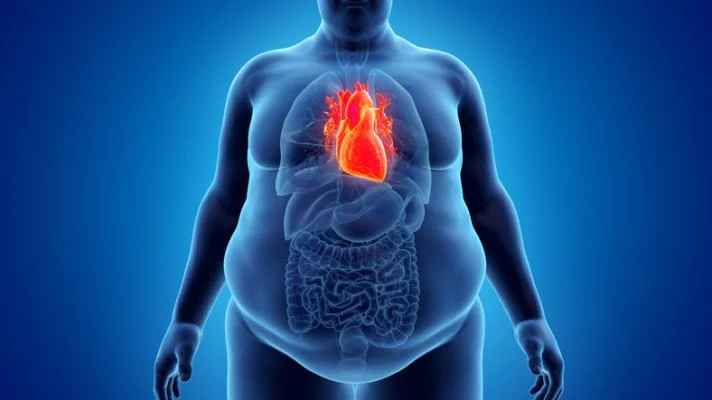Obesity is a growing health concern in the United States, affecting millions of individuals across all age groups. This article explores the trends in obesity, its causes, associated health risks, and strategies for prevention and management.
Introduction
In recent years, obesity has become an alarming issue in the United States, with a significant rise in the number of individuals classified as overweight or obese. This article delves into the factors contributing to this trend and explores the implications for public health.
Definition of Obesity
Obesity is a medical condition characterized by an excessive accumulation of body fat that poses a risk to an individual’s health. It is typically measured using the body mass index (BMI), which takes into account a person’s height and weight. A BMI of 30 or above is considered obese.
- Global Obesity Statistics:
- Worldwide obesity rate has nearly doubled since 1980
- Predicted by 2030: 1 in 5 women and 1 in 7 men will have obesity
- More people have obesity than underweight in most regions
- Obesity and COVID-19:
- Obesity increases the risk of severe illness and hospitalization from COVID-19
- Obesity rate in the U.S. increased by 3% during the pandemic
- Obesity and Health Risks:
- 4 million deaths annually due to obesity
- Obesity linked to 30%-53% of new diabetes cases in the U.S.
- Medical costs for people with obesity tend to be 30%-40% higher
- Obesity increases missed work days by an estimated three days per year
- Obesity Prevalence:
- U.S. Adults: 41.9% have obesity based on data from 2017-2020
- U.S. Adolescents and Children: 19.7% have obesity (14.7 million individuals) based on the same data
- Worldwide: Over 1 billion people have obesity (650 million adults, 340 million adolescents, 39 million children)
Prevalence of Obesity in the United States
The prevalence of obesity in the United States has reached epidemic proportions. According to recent statistics, more than 40% of adults and 18.5% of children and adolescents are obese. These numbers have been steadily increasing over the past few decades, indicating a worrisome trend.
Factors Contributing to Obesity
Several factors contribute to the rising rates of obesity in the United States. Understanding these factors is crucial in developing effective strategies to address and prevent obesity.
Sedentary Lifestyle
The modern sedentary lifestyle, characterized by a lack of physical activity, is a significant contributor to obesity. Many Americans spend a substantial amount of time sitting or engaging in activities that require minimal movement, such as working at a desk or watching television.
Poor Diet and Nutrition
Unhealthy eating habits, including the consumption of high-calorie, processed foods and sugary beverages, play a pivotal role in the obesity epidemic. These foods are often readily available, affordable, and heavily marketed, making them a common choice for many individuals.
Genetic Factors
Genetic predisposition to obesity can influence an individual’s likelihood of developing the condition. Certain genes may affect appetite, metabolism, and fat storage, making some people more susceptible to weight gain.
Environmental Factors
Environmental factors such as easy access to unhealthy foods, lack of safe recreational spaces, and limited availability of fresh and nutritious foods in certain neighborhoods contribute to the obesity problem. These environmental barriers can make it challenging for individuals to make healthy choices.
Health Risks Associated with Obesity
Obesity is not just a cosmetic concern; it significantly impacts overall health and increases the risk of various chronic diseases. Some of the health risks associated with obesity include:
Cardiovascular Diseases
Obesity is a major risk factor for cardiovascular diseases such as heart disease, stroke, and high blood pressure. The excess body fat strains the heart and blood vessels, leading to increased cholesterol levels, plaque buildup in the arteries, and reduced heart function.
Type 2 Diabetes
Obesity is closely linked to the development of type 2 diabetes. Excess body weight and unhealthy eating habits can lead to insulin resistance, where the body’s cells become less responsive to insulin. This condition can ultimately result in high blood sugar levels and the onset of diabetes.
Hypertension
High blood pressure is a common consequence of obesity. The increased weight puts additional pressure on the blood vessels, leading to elevated blood pressure levels. Hypertension increases the risk of heart disease, stroke, and kidney problems.
Sleep Apnea
Obesity is a significant risk factor for sleep apnea, a sleep disorder characterized by pauses in breathing or shallow breathing during sleep. The excess fat around the neck and throat can obstruct the airway, causing interrupted breathing patterns and disruptions in sleep.
Joint Problems
Excessive weight puts strain on the joints, particularly in the knees, hips, and lower back. This can lead to conditions such as osteoarthritis, where the protective cartilage in the joints wears down, causing pain, stiffness, and reduced mobility.
Childhood Obesity
The prevalence of childhood obesity in the United States is also a growing concern. Childhood obesity can have severe long-term consequences and should be addressed through preventive measures and intervention strategies.
Causes and Consequences
Childhood obesity is primarily attributed to a combination of genetic, behavioral, and environmental factors. Unhealthy eating patterns, sedentary lifestyle, limited access to nutritious foods, and family history of obesity all contribute to its development. Childhood obesity can lead to physical and psychological health issues, as well as poor academic performance and social challenges.
Prevention and Intervention Strategies
Preventing and addressing childhood obesity requires a comprehensive approach involving parents, schools, healthcare professionals, and the community. Strategies include promoting healthy eating habits, increasing physical activity, providing nutrition education, and creating supportive environments for children to make healthy choices.
Socioeconomic Factors and Obesity
There is a significant association between socioeconomic status and obesity. Individuals with lower incomes and limited access to resources often face barriers to adopting healthy lifestyles. The availability of affordable, nutritious food options and safe recreational spaces is crucial in combating obesity in disadvantaged communities.
Role of Advertising and Marketing
The food and beverage industry plays a significant role in shaping dietary choices and contributing to the obesity epidemic. The aggressive marketing of high-calorie, low-nutrient foods and beverages, particularly towards children, influences consumption patterns and contributes to poor dietary habits.
Government Initiatives and Public Health Policies
The government has implemented various initiatives and public health policies to combat obesity. These include promoting nutrition labeling, advocating for healthier school meals, implementing sugar-sweetened beverage taxes, and supporting community programs that encourage physical activity and healthy lifestyles.
Obesity Treatment and Management
Managing obesity involves a multidisciplinary approach tailored to individual needs. Treatment options include:
Diet and Exercise
A balanced, calorie-controlled diet and regular physical activity are the cornerstone of obesity management. Creating a sustainable, personalized plan that focuses on long-term behavior changes is essential for successful weight loss and maintenance.
Medications and Supplements
In some cases, medications may be prescribed to aid in weight loss for individuals with obesity-related health complications. These medications suppress appetite, reduce fat absorption, or increase metabolism. However, they are typically used as an adjunct to lifestyle modifications.
Bariatric Surgery
For individuals with severe obesity and related health problems, bariatric surgery may be an option. Procedures such as gastric bypass or sleeve gastrectomy can help promote weight loss by reducing stomach size or altering the digestive process.
Psychological Factors and Obesity
Psychological factors can significantly impact eating behaviors and contribute to obesity. Emotional eating, stress, depression, and anxiety can all influence food choices and eating patterns, leading to weight gain and difficulties in weight management.
Addressing these psychological factors through therapy, counseling, and support groups can be integral to comprehensive obesity treatment.
Obesity and Mental Health
Obesity and mental health often coexist, creating a complex relationship between the two. Obesity can contribute to low self-esteem, body image issues, and social isolation, negatively impacting mental well-being. Conversely, individuals with mental health conditions may be at a higher risk of developing obesity due to emotional eating or medication side effects.
Addressing Stigma and Discrimination
Obesity is often stigmatized, leading to discrimination and bias against individuals with obesity. This can further exacerbate the physical and mental health challenges they face.
Raising awareness, promoting body positivity, and fostering inclusive environments are crucial steps in addressing stigma and creating a supportive society for individuals with obesity.
Obesity Prevention Strategies
Preventing obesity requires a multifaceted approach involving individuals, communities, healthcare providers, and policymakers. Some key strategies include:
- Promoting healthy eating habits from an early age
- Encouraging regular physical activity and reducing sedentary behaviors
- Creating environments that support and facilitate healthy lifestyles, such as access to affordable, nutritious foods and safe recreational spaces
- Implementing comprehensive school wellness programs
- Enhancing nutrition education and literacy
- Advocating for policies that promote healthier food options and limit the marketing of unhealthy products to children
Conclusion
The rising trends in obesity in the United States pose significant challenges to public health. Understanding the factors contributing to obesity, its associated health risks, and effective prevention and management strategies is crucial in addressing this epidemic. By promoting healthy lifestyles, implementing supportive policies, and addressing the underlying social and environmental factors, we can work towards a healthier future for individuals and communities.
FAQs
1. Can genetics alone cause obesity? Genetics can influence an individual’s susceptibility to weight gain, but it is not the sole determinant of obesity. Lifestyle factors, such as diet and physical activity, play a significant role in weight management.
2. Are all obese individuals at risk for health problems? While obesity increases the risk of various health conditions, not all obese individuals will develop health problems. Factors such as overall health, genetics, and lifestyle habits contribute to the overall risk profile.
3. Can childhood obesity be reversed? With early intervention and lifestyle modifications, childhood obesity can be addressed and reversed. Encouraging healthy eating, physical activity, and supportive environments are key in preventing long-term health consequences.
4. Are there medications for weight loss? There are medications available for weight loss, but they are typically prescribed for individuals with obesity-related health complications. These medications should be used under medical supervision and in conjunction with lifestyle changes.
5. How can society support individuals with obesity? Society can support individuals with obesity by promoting body positivity, reducing weight-based stigma, and creating inclusive environments. Access to affordable, healthy foods and opportunities for physical activity should be prioritized for all individuals, regardless of their weight.







